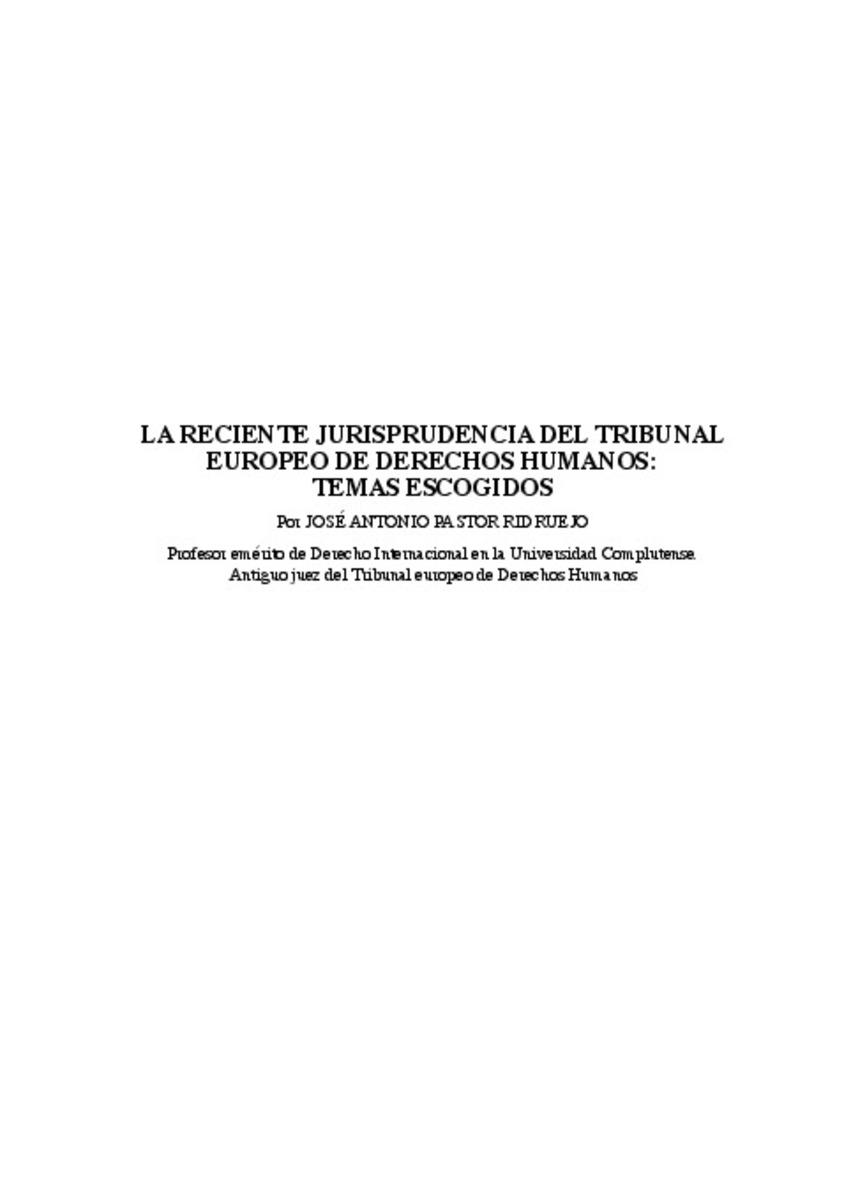Mostrar el registro sencillo del ítem
La reciente jurisprudencia del Tribunal Europeo de Derechos Humanos: temas escogidos
| dc.contributor.author | Pastor Ridruejo, José Antonio | |
| dc.date.accessioned | 2018-11-27T18:24:26Z | |
| dc.date.available | 2018-11-27T18:24:26Z | |
| dc.date.issued | 2007 | |
| dc.identifier.uri | http://hdl.handle.net/10234/177702 | |
| dc.description | Ponencia recogida en las actas de los Cursos de Derecho Internacional y Relaciones Internacionales de Vitoria-Gasteiz organizados por la Facultad de Derecho de la Universidad del País Vasco. | ca_CA |
| dc.description.abstract | . Ha de quedar claro que en este curso no hablamos del término jurisprudencia en el sentido utilizado por los juristas romanos (divinarum atque humanarum rerum notitia, iusti atque iniusti scientae) y seguido de un modo general por los juristas anglosajones: ciencia general del Derecho ligada a una cierta cultura general. Empleamos aquí el vocablo jurisprudencia en un sentido diferente, que es el que le atribuyen hoy los juristas del Viejo Continente, y entre ellos los españoles, para designar el conjunto de principios o normas que emanan de las sentencias de los tribunales y que se entiende son vinculantes. Es obvio que de las ya muy abundantes sentencias del Tribunal europeo de derechos humanos resultan buen número de principios o normas, o lo que es lo mismo, una doctrina jurisprudencial consolidada que se caracteriza por su gran calidad y alta originalidad, e incluso como han dicho algunos autores por su elevada sofisticación. Sobre las manifestaciones recientes y más relevantes de esta jurisprudencia van a versar mis enseñanzas. | ca_CA |
| dc.description.abstract | It should be clear that in this course we do not talk about the term jurisprudence in the sense used by the Roman jurists (divinarum atque humanarum rerum notitia, iusti atque iniusti scientae) and followed in a general way by the jurists Anglo-Saxon: general science of law linked to a certain general culture. We use here the term jurisprudence in a different sense, which is what At present, the jurists of the Old Continent, and among them the Spaniards, designate the set of principles or rules that emanate from the judgments of the courts and that is understood to be binding. It is obvious that of the already very abundant European Court of Human Rights decisions result in a large number of principles or norms, or what is the same, a consolidated jurisprudential doctrine which is characterized by its high quality and high originality, and even as they said some authors for their high sophistication. On recent manifestations and most relevant of this jurisprudence will go to versar my teachings. | ca_CA |
| dc.format.extent | 38 p. | ca_CA |
| dc.format.mimetype | application/pdf | ca_CA |
| dc.language.iso | spa | ca_CA |
| dc.publisher | Universidad del País Vasco/Euskal Herriko Unibertsitatea, Servicio Editorial | ca_CA |
| dc.rights.uri | http://rightsstatements.org/vocab/CNE/1.0/ | * |
| dc.subject | Jurisprudencia | ca_CA |
| dc.title | La reciente jurisprudencia del Tribunal Europeo de Derechos Humanos: temas escogidos | ca_CA |
| dc.type | info:eu-repo/semantics/conferenceObject | ca_CA |
| dc.rights.accessRights | info:eu-repo/semantics/openAccess | ca_CA |
| dc.relation.publisherVersion | https://www.ehu.eus/es/web/cursosderechointernacionalvitoria/ponencias | ca_CA |
| dc.subject.eurovoc | Tribunal Europeo de Derechos Humanos | ca_CA |
| dc.subject.eurovoc | European Court of Human Rights | ca_CA |







